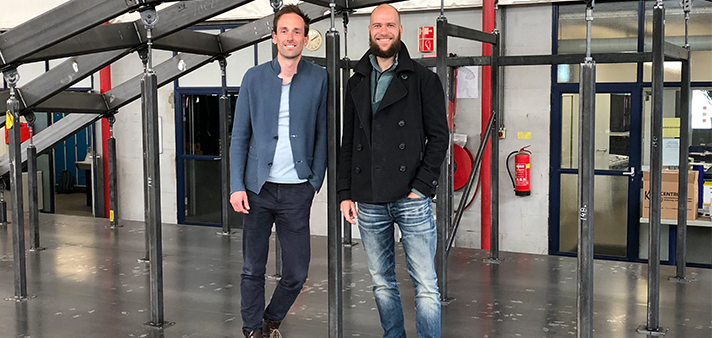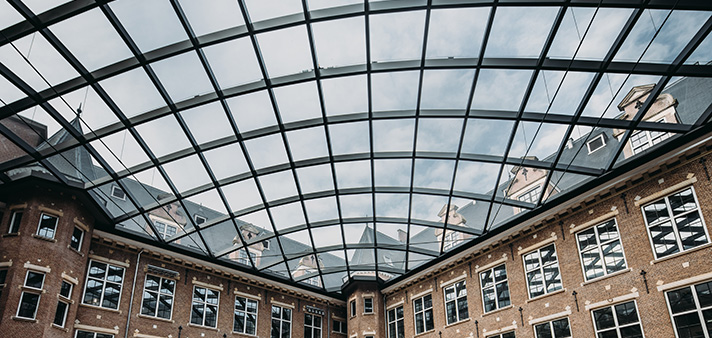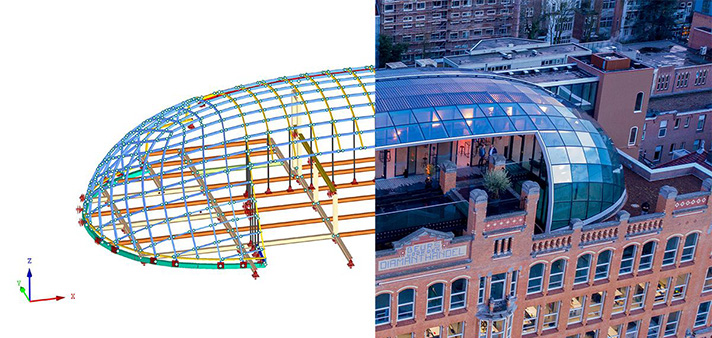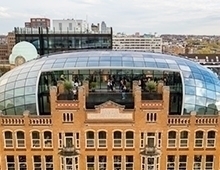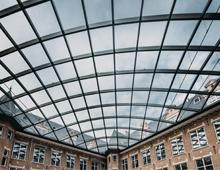Do you have innovative ideas, dreams or designs that are seemingly impossible? We are eager to solve your architectural challenges! Contact us so we can be of assistance.
Parametric design
How a challenge drives innovation
Our customers have a vision, they want the highest quality and most innovative of what architecture has to offer. Often the client, in collaboration with an architect, has already completed a design in which a certain part is new or experimental or does not exist at all. The complexity of the issues are enormous and unique for each project. This stimulates an innovating attitude – aimed at bringing challenging architecture to life. This is the challenge that we as Octatube are happy to take on. In fact, it has led us to develop new smart software.
Technological developments are rapid. With 3D-models, we can calculate and simulate a lot. The best thing about the way we work is that clever minds work closely together with experienced craftsmen in our workshop. This interaction is certainly beneficial in terms of the design and the execution of our projects. Especially with parts that are very specialist, new or experimental.
Challenge
This is also the case for the project Capital C Amsterdam (The Diamantbeurs), which started in 2016. The design for this project, by ZJA Zwarts & Jansma Architects, is very bespoke and innovative. The large dome of approximately 45x21x10 metres (lxbxh) will be a two-storey dome with a free shape. This means that it cannot be defined by a certain basic geometrical shape such as a sphere or cube.
The shape of the gridshell is determined by a parametric computer model. ZJA translated the design of the roof structure in a parametric computer model that generates results for the purpose of production. In the by ZJA developed software the boundary conditions were defined, with the software searching for the ideal shape. In the case of Capital C, the ideal shape was a geometrical free-form shape but with planar or minimal curved quadrilateral glass. This to represent the faceted aesthetics of the diamond, referencing the building’s heritage. In addition to the look, optimizing planar glass panes also increased the feasibility and cost-efficiency of the design.
The team of Octatube took on the engineering (the technical development and structural calculations) of the design by ZJA.
Koos Fritzsche, Sales engineer at Octatube: “In the first phase when Octatube is involved in a project, seated at the table with client, architect, technical advisor and contractor; the design is still under development. Mostly, complex geometries of designs are defined only by the main parameters. With parametric software, we support the client to analyse alternatives and to optimize the design. These models will later form the basis for the technical engineering of the project.”
In the project Diamantbeurs, the basic geometry was given, but the grid was still under development.
What is a grid?
A grid is the representation of the 3D shape with structural elements of the buildings, schematized in lines or wires. A grid is the base, the starting point, for the technical drawings and the following production of the project.
This situation raised the following question:
How can the technical drawings be efficiently set up and the production prepared, before the basic geometry is established?
As a Design & Build company, Octatube is at the forefront of realizing challenging architecture with an emphasis on high-quality applications of glass and steel. In order to engineer the often complex projects, a flexible technical software package is required. The often unique elements can then be modelled per project. Within Octatube, Inventor, an Autodesk modelling program, is used in combination with Rhinoceros (Rhino) and Grasshopper.
With Inventor, we can accurately create 3D models to technically work out, visualise and simulate the design of a building before it is produced. This happens up to every last bolt and adjusting ring. Rhino is used as a design and engineering tool which, together with Grasshopper (a parametric design tool), makes the main outlines of a model. A link between the systems had already been developed by Octatube but it was limited and not interactive, as we envisioned for the Capital C project.
Due to the free form of the project, all parts (steel beams, glass panels, etc.) are different and differently come together geometrically. This large number of unique elements and connections could be modelled 1 by 1. If the grid would change at any time, all or a large part of the parts would have to change as well. After all, all parts are connected to each other. Despite this, there is a lot of repetition in the broad outline design. This raised the idea of automating the design by developing a parametric tool that converts the complex basic geometry into a detailed production model.
What exactly is parametric design?
Parametric design is a design process in which a design can be generated on the basis of data and relations between parts. In addition to designing complex geometries and constructions, parametric design also offers possibilities for making changes to a responsive model later on in the design process. This process makes it possible to quickly generate models, test different scenarios, make performance transparent and therefore create added value for clients. Instead of manually sketching only a few possibilities, you can test many options. An optimal solution must be chosen from all possible models. In addition, it is much easier to change the relations between spaces or dimensions later in the process, since the dynamic building model is part of the design process in real time. (Source: www.bna.nl)
Parametric Tool
A model in Rhino actually consists of points and lines, a schematic representation of the actual construction or geometry: the lines are the beams and the points are the joints. Properties such as profile dimensions and materialisation are linked to these elements.
Grasshopper, a plug-in for Rhino, offers opportunities to play with geometry interactively and in a relatively simple way. By setting up the geometry parametrically, all properties remain continuously adaptable. One of the simplifications is the development of variants.
Within this program a tool has been developed by Octatube that can export the wire model to Inventor, after the variant study and optimization, and then create all the parts required for production.
Arend van Waart, programmer at Octatube: "The main goal is to bring knowledge forward in the design process. To know as soon as possible where we stand. The more iterations you can make, the faster you know what the total looks like. This makes it easier to see whether you have overlooked something and if you can do something about it. We make and optimize a building component and then check whether the output is still correct. You start with the part that provides the best benefits. That is the part that occurs most often.”
The great thing about this design process is that you don't have to start over and over again if something has changed. All you have to do is take the piece that needs to be changed. The most common, regular parts are done with the tool, but other, more complex parts and connection points are not. If you start programming every exception, it becomes too complicated. Normally you make 4 bars and 1 node with all the complexity in it, but in this design process we succeeded to make node-free connections that look more elegant.
In the end, we designed 9 different types of beams. They differ from each other because of the different connections. The engineer determines in the system where the various connection points will be located, which is the first step. The second step is the manufacturing of the beams and in the third step the building components are grouped and then assembled.
File-to-factory
In addition to the fact that Octatube has developed software for this project, a file-to-factory working method has been devised and implemented. If, for example, a certain composite element has to be made, then the required separate parts are prepared on one pallet. The parts are numbered and placed in a specific order on the palette. Then, the parts can be mounted on an adjustable mould with legs (also known as a nail bed).
Daniel van Kersbergen, engineer at Octatube: "All the tubes are made file-to-factory and are prepared on the palette. All connections are digitized. The adjustable mould is a newly designed component. All complexity automatically comes out of the computer; the height, the position of the part and the degrees. The geometry of the model is extremely complicated because everything is skewed. The nail bed ensures that all complexity of the model can still be mounted in one go.”
Actually, something very complicated has been brought back to something simple. Everything is cleverly engineered, so that it can be assembled quickly on site.
Vincent Monteiro Chantre, foreman at Octatube: "It's a beautiful way of working. In advance we determined where the connections of the parts should go. You don't have to measure to place the parts, it is a wonderful system. The biggest challenge is to achieve the exact size. When you weld, you have to be able to estimate what the material is going to do. We determine our welding direction and position before we start. Of course you have to premeasure when the structure is put together. The fact that the practical and the theoretical part come together at an early stage is a real advantage.”
Future
The process described above is focused on unique parts. Developing the smart software and tools initially takes a lot of work. In the future we will reap the benefits of this. Although digital manufacturing is often mentioned, it does not happen very often in practice. This project proves that it is possible and that it will eventually save time and therefore costs. In the future, Octatube will further expand the optimisation tool it has developed. We’ll apply it to a wider range of challenging projects.
Daniel van Kersbergen: "In all fields, we invest a lot of time in developing tools and developing ourselves to be able to achieve what we set out to do. The new software and working method have been very well thought out. As a result, we have gained a great deal of knowledge, energy and software developments which we will be able to reuse again. Capital C is an ambitious project that has challenged us to innovate further!"

